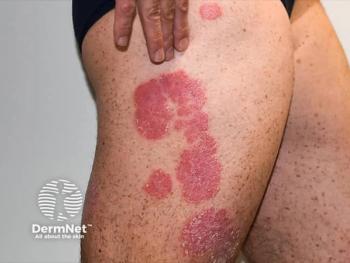
- Dermatology Times, May 2025 (Vol. 46. No. 05)
- Volume 46
- Issue 05
Exploring the Role of GLP-1 Receptor Agonists in Psoriasis
Key Takeaways
- GLP-1RAs, used for type 2 diabetes, show potential in psoriasis management due to their anti-inflammatory and immunomodulatory effects.
- These medications improve glucose metabolism, support weight loss, and reduce systemic inflammation, potentially alleviating psoriasis symptoms.
Explore the potential of GLP-1 receptor agonists in psoriasis management, highlighting their immunomodulatory effects and metabolic benefits for patients.
Genetic, environmental, and immune factors play a key role in psoriasis as a chronic inflammatory skin condition. Its inflammation is driven by immune cell migration and the secretion of proinflammatory cytokines, including tumor necrosis factor-α (TNF-α), IL-17, and IL-23.1
Although traditional treatments target immune dysregulation, recent studies have explored the potential role of glucagon-like peptide-1 receptor agonists (GLP-1RAs) in managing psoriasis. These medications, primarily used for type 2 diabetes (T2D) and obesity, exhibit anti-inflammatory and immunomodulatory effects that may benefit patients with psoriasis.2 With increasing interest in repurposing GLP-1RAs for dermatologic conditions, dermatology clinicians must understand their mechanisms and clinical implications.
Metabolic and Systemic Benefits
GLP-1RAs mimic the incretin hormone GLP-1, which plays a key role in glucose metabolism by stimulating insulin secretion, delaying gastric emptying, and reducing appetite.3 These medications enhance blood glucose control, support weight loss, and lower cardiovascular risk.4
Given that psoriasis is associated with metabolic comorbidities such as obesity, T2D, and cardiovascular disease, GLP-1RAs may offer additional benefits beyond glycemic control. Both obesity and chronic hyperglycemia contribute to systemic inflammation, a key driver of psoriasis severity. By improving insulin sensitivity, promoting weight loss, and reducing systemic inflammation, GLP-1RAs may help mitigate psoriasis symptoms and the associated metabolic burden.5-7
Immunomodulatory Effects on Psoriasis
GLP-1RAs impact metabolism and exhibit immunomodulatory effects, influencing key pathways involved in psoriasis. Their anti-inflammatory properties, seen with agents such as liraglutide, may help improve psoriasis independently of weight loss or blood glucose control.8
Research suggests that psoriasis improvement with GLP-1RAs can occur before noticeable changes in weight or glucose levels, highlighting a direct immunomodulatory effect. These medications may benefit psoriasis through several mechanisms9-12:
- Modulation of cells that drive inflammation: Invariant natural killer T (iNKT) cells contribute to psoriasis by driving inflammation. GLP-1RAs help by redistributing these cells from psoriatic plaques to the bloodstream, reducing local inflammation and restoring immune balance. This process also promotes anti-inflammatory signaling by increasing the production of IL-10, further supporting psoriasis improvement.
- Reduction in γδ T Cells: Dermal γδ T cells are another important contributor to psoriasis pathogenesis, primarily through the production of IL-17. GLP-1RAs have been shown to decrease γδ T-cell activity in psoriatic lesions, leading to decreased IL-17 levels and clinical improvement in psoriasis severity.
- Inhibition of TNF-α signaling and immune cell migration: There is some evidence that GLP-1RAs inhibit TNF-α signaling and reduce immune cell migration, including CD4+ lymphocytes. Collectively, these changes lead to reduced proinflammatory cytokine production, which further mitigates the inflammatory response in psoriasis.
Clinical Evidence
Several studies have evaluated the impact of GLP-1RAs on psoriasis severity in patients with T2D. Research has demonstrated significant improvements in the Psoriasis Area Severity Index, along with concurrent reductions in anti-inflammatory markers:
- Hogan et al reported psoriasis improvement within 48 hours of initiating exenatide, alongside increased iNKT cell redistribution.9
- Buysschaert et al observed significant reductions in γδ T cells and psoriasis severity after 20 weeks of liraglutide treatment.10
- Lin et al conducted a randomized controlled trial showing that liraglutide significantly reduced psoriasis severity and suppressed the expression of IL-23, IL-17, and TNF-α.11
However, when it comes to disease impact in patients without T2D, research is inconclusive. Faurschou et al found that liraglutide did not improve psoriasis severity in obese patients without T2D, suggesting that metabolic status may influence response.13
These findings suggest that although GLP-1RAs show promise, their effects may be more pronounced in patients with concurrent metabolic dysfunction. Further research is needed to assess their efficacy in broader patient populations.
Implications for Dermatology Practice
For dermatologists, GLP-1RAs present a potential adjunctive therapy for patients with psoriasis and T2D. Clinicians should consider the following:
- Patient Selection: Patients with both psoriasis and T2D may benefit the most from GLP-1RAs.
- Multidisciplinary Collaboration: Coordination with endocrinologists can optimize treatment strategies for patients with metabolic-dermatologic comorbidities.
- Need for Further Research: Although promising, current evidence does not yet support the routine use of GLP-1RAs in patients with psoriasis who do not have metabolic disorders.
Conclusion
The emerging role of GLP-1RAs in psoriasis management highlights the evolving intersection of metabolic and dermatologic health. Although preliminary studies indicate significant immunomodulatory benefits, further clinical trials are necessary to determine their full potential. Dermatologists should remain informed about ongoing research and consider GLP-1RAs as part of an integrated approach for managing psoriasis in patients with T2D.
Jennifer Fisher, MMSc, PA-C, is a board-certified dermatology physician assistant and medical writer in Connecticut.
References
- Qasem SF, Ashkanani H, Ali A. Therapeutic advancements in the management of psoriasis: a clinical overview and update. Cureus. 2025;17(2):e79097. doi:10.7759/cureus.79097
- Paschou IA, Sali E, Paschou SA, Psaltopoulou T, Nicolaidou E, Stratigos AJ. GLP-1RAs in patients with psoriasis. Hormones (Athens). Published online February 20, 2025. doi:10.1007/s42000-025-00635-5
- Drucker DJ. Mechanisms of action and therapeutic application of glucagon-like peptide-1. Cell Metab. 2018;27(4):740-756. doi:10.1016/j.cmet.2018.03.001
- Verma S, Al-Omran M, Leiter LA, et al. Cardiovascular efficacy of liraglutide and semaglutide in individuals with diabetes and peripheral artery disease. Diabetes Obes Metab. 2022;24(7):1288-1299. doi:10.1111/dom.14700
- Haran K, Johnson CE, Smith P, et al. Impact of GLP-1 receptor agonists on psoriasis and cardiovascular comorbidities: a narrative review. Psoriasis (Auckl). 2024;14:143-152. doi:10.2147/PTT.S485061
- Wan MT, Shin DB, Hubbard RA, Noe MH, Mehta NN, Gelfand JM. Psoriasis and the risk of diabetes: a prospective population-based cohort study. J Am Acad Dermatol. 2018;78(2):315-322.e1. doi:10.1016/j.jaad.2017.10.050
- Xu X, Lin L, Chen P, et al. Treatment with liraglutide, a glucagon-like peptide-1 analogue, improves effectively the skin lesions of psoriasis patients with type 2 diabetes: a prospective cohort study. Diabetes Res Clin Pract. 2019;150:167-173. doi:10.1016/j.diabres.2019.03.002
- Chang G, Chen B, Zhang L. Efficacy of GLP-1rA, liraglutide, in plaque psoriasis treatment with type 2 diabetes: a systematic review and meta-analysis of prospective cohort and before-after studies. J Dermatolog Treat. 2022;33(3):1299-1305. doi:10.1080/09546634.2021.1882658
- Hogan AE, Tobin AM, Ahern T, et al. Glucagon-like peptide-1 (GLP-1) and the regulation of human invariant natural killer T cells: lessons from obesity, diabetes and psoriasis. Diabetologia. 2011;54(11):2745-2754. doi:10.1007/s00125-011-2232-3
- Buysschaert M, Tennstedt D, Preumont V. Improvement of psoriasis during exenatide treatment in a patient with diabetes. Diabetes Metab. 2012;38(1):86-88. doi:10.1016/j.diabet.2011.11.004
- Lin L, Xu X, Yu Y, et al. Glucagon-like peptide-1 receptor agonist liraglutide therapy for psoriasis patients with type 2 diabetes: a randomized-controlled trial. J Dermatolog Treat. 2022;33(3):1428-1434. doi:10.1080/09546634.2020.1826392
- Marx N, Burgmaier M, Heinz P, et al. Glucagon-like peptide-1(1-37) inhibits chemokine-induced migration of human CD4-positive lymphocytes. Cell Mol Life Sci. 2010;67(20):3549-3555. doi:10.1007/s00018-010-0396-5
- Faurschou A, Gyldenløve M, Rohde U, et al. Lack of effect of the glucagon-like peptide-1 receptor agonist liraglutide on psoriasis in glucose-tolerant patients — a randomized placebo-controlled trial. J Eur Acad Dermatol Venereol. 2015;29(3):555-559. doi:10.1111/jdv.12629
Articles in this issue
Newsletter
Like what you’re reading? Subscribe to Dermatology Times for weekly updates on therapies, innovations, and real-world practice tips.


















